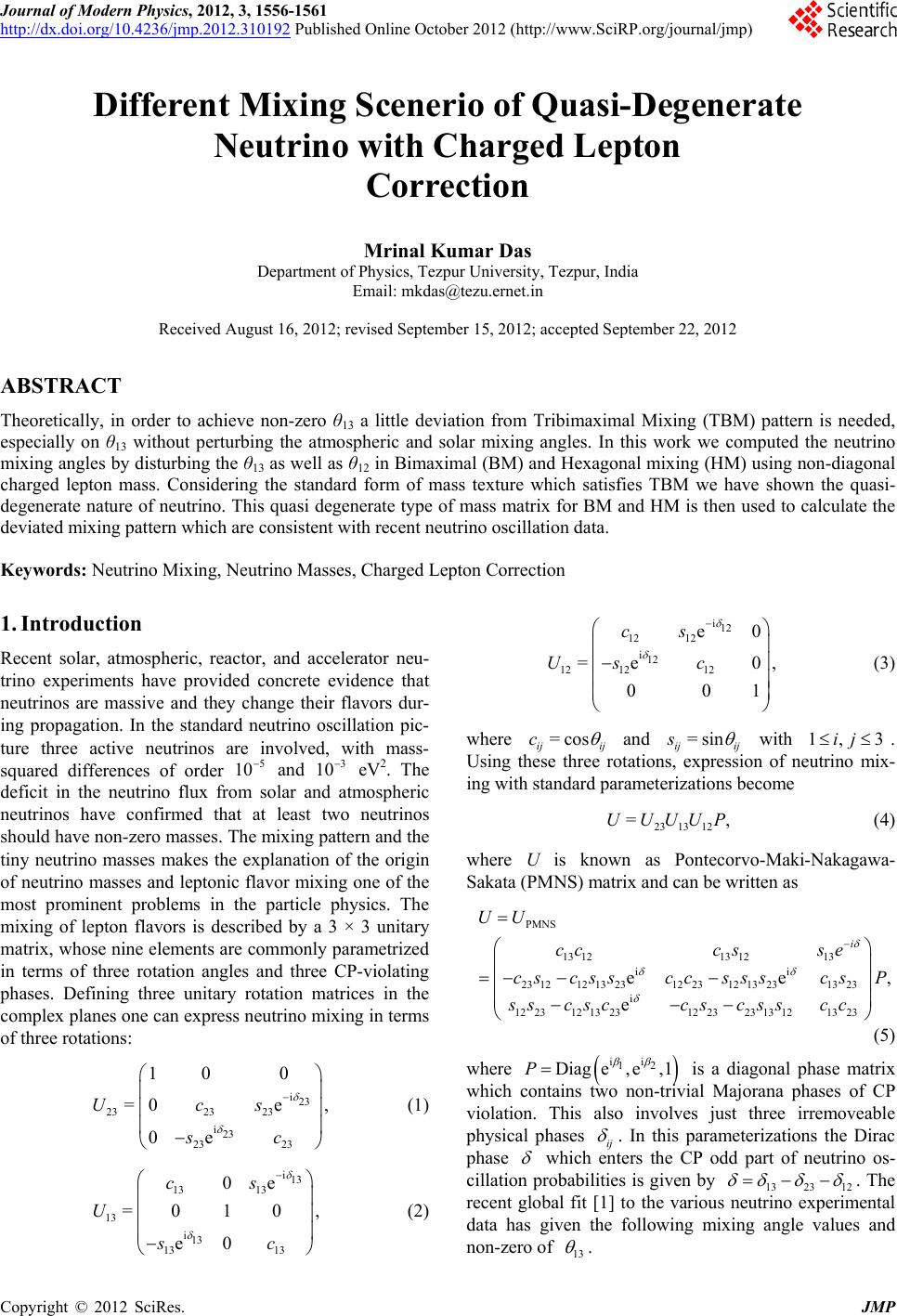 Journal of Modern Physics, 2012, 3, 1556-1561 http://dx.doi.org/10.4236/jmp.2012.310192 Published Online October 2012 (http://www.SciRP.org/journal/jmp) Different Mixing Scenerio of Qu asi-Degenerate Neutrino with Charged Lepton Correction Mrinal Kumar Das Department of Physics, Tezpur University, Tezpur, India Email: mkdas@tezu.ernet.in Received August 16, 2012; revised September 15, 2012; accepted September 22, 2012 ABSTRACT Theoretically, in order to achieve non-zero θ13 a little deviation from Tribimaximal Mixing (TBM) pattern is needed, especially on θ13 without perturbing the atmospheric and solar mixing angles. In this work we computed the neutrino mixing angles by disturbing the θ13 as well as θ12 in Bimaximal (BM) and Hexagonal mixing (HM) using non-diagonal charged lepton mass. Considering the standard form of mass texture which satisfies TBM we have shown the quasi- degenerate nature of neutrino. This quasi degenerate type of mass matrix for BM and HM is then used to calculate the deviated mixing pattern which are consistent with recent neutrino oscillation data. Keywords: Neutrino Mixing, Neutrino Masses, Charged Lepton Correction 1. Introduction Recent solar, atmospheric, reactor, and accelerator neu- trino experiments have provided concrete evidence that neutrinos are massive and they change their flavors dur- ing propagation. In the standard neutrino oscillation pic- ture three active neutrinos are involved, with mass- squared differences of order 10 and 10 eV2. The deficit in the neutrino flux from solar and atmospheric neutrinos have confirmed that at least two neutrinos should have non-zero masses. The mixing pattern and the tiny neutrino masses makes the explanation of the origin of neutrino masses and leptonic flavor mixing one of the most prominent problems in the particle physics. The mixing of lepton flavors is described by a 3 × 3 unitary matrix, whose nine elements are commonly parametrized in terms of three rotation angles and three CP-violating phases. Defining three unitary rotation matrices in the complex planes one can express neutrino mixing in terms of three rotations: 53 i23 23 23 23 0 e , 0e s sc i13 13 13 0e 10, cs sc i12 12 12 i12 12 1212 e0 =e 0, 001 cs Us c =cosc 23 23 i 10 =0Uc 23 13 13 i13 =0 e0 U (1) 13 (2) (3) where ij ij and ij ij =sins1, 3ij with 23 13 12 =,UUUUP PMNS 13 1213 1213 ii 23121213 2312231213 2313 23 i 12 231213 2312 2323131213 23 ee, e i UU cccs se cs cssccssscsP ss csccs csscc . Using these three rotations, expression of neutrino mix- ing with standard parameterizations become (4) where U is known as Pontecorvo-Maki-Nakagawa- Sakata (PMNS) matrix and can be written as (5) where ii 12 Diage, e,1P is a diagonal phase matrix which contains two non-trivial Majorana phases of CP violation. This also involves just three irremoveable physical phases ij . In this parameterizations the Dirac phase which enters the CP odd part of neutrino os- cillation probabilities is given by 1323 12 13 . The recent global fit [1] to the various neutrino experimental data has given the following mixing angle values and non-zero of . C opyright © 2012 SciRes. JMP 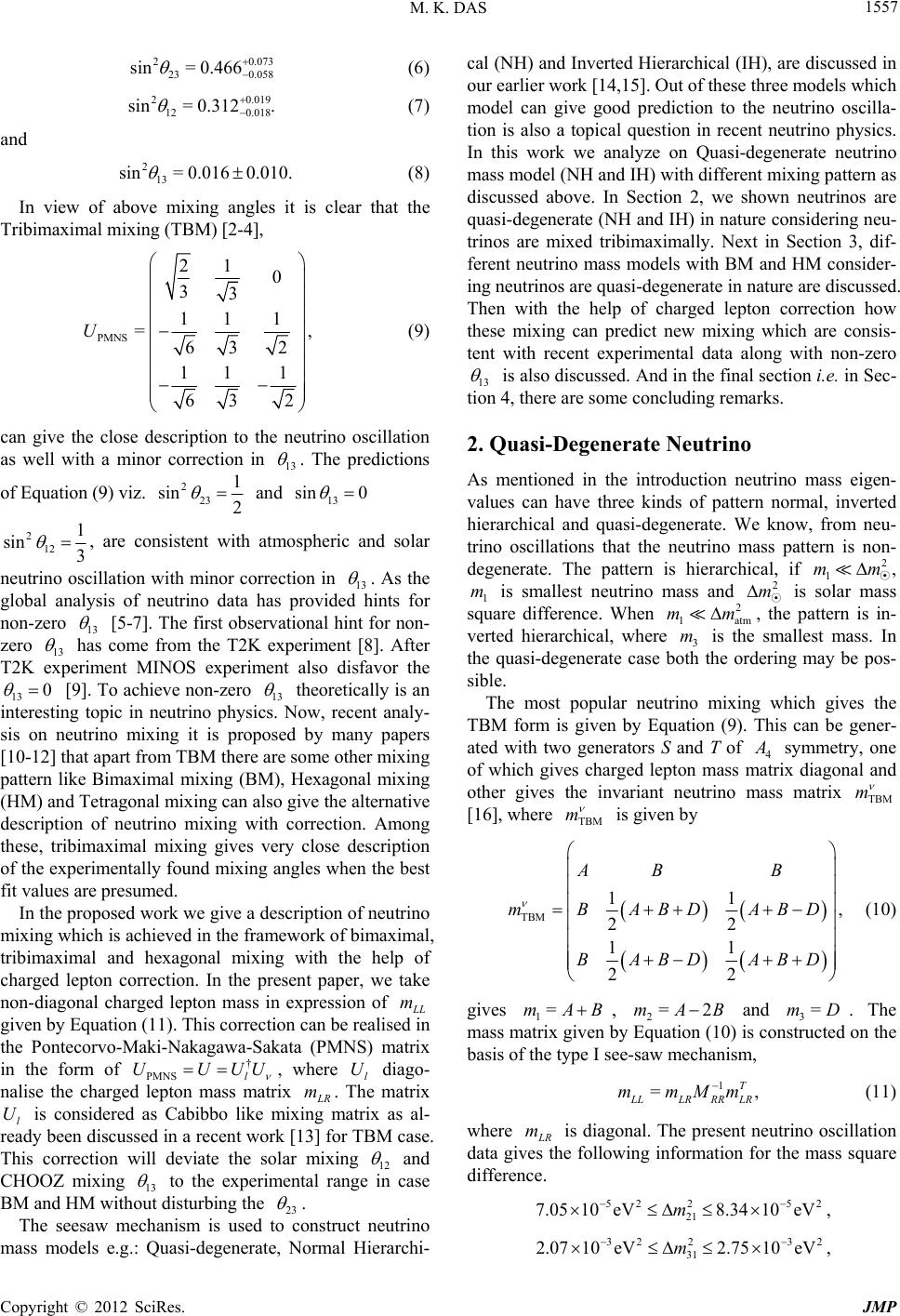 M. K. DAS 1557 2 23 sin 0.073 0.058 = 0.466 0.019 0.018 = 0.312 0.016 0.010. (6) 2 12 sin . (7) and 2 13 sin = (8) In view of above mixing angles it is clear that the Tribimaximal mixing (TBM) [2-4], PMNS 3 U 21 0 3 11 1 =, 632 11 1 63 2 13 (9) can give the close description to the neutrino oscillation as well with a minor correction in . The predictions of Equation (9) viz. 2 sin 23 1 2 13 sin 0 and 2 12 sin3 1, are consistent with atmospheric and solar neutrino oscillation with minor correction in 13 . As the global analysis of neutrino data has provided hints for non-zero 13 [5-7]. The first observational hint for non- zero 13 has come from the T2K experiment [8]. After T2K experiment MINOS experiment also disfavor the 13 0 [9]. To achieve non-zero 13 theoretically is an interesting topic in neutrino physics. Now, recent analy- sis on neutrino mixing it is proposed by many papers [10-12] that apart from TBM there are some other mixing pattern like Bimaximal mixing (BM), Hexagonal mixing (HM) and Tetragonal mixing can also give the alternative description of neutrino mixing with correction. Among these, tribimaximal mixing gives very close description of the experimentally found mixing angles when the best fit values are presumed. In the proposed work we give a description of neutrino mixing which is achieved in the framework of bimaximal, tribimaximal and hexagonal mixing with the help of charged lepton correction. In the present paper, we take non-diagonal charged lepton mass in expression of L given by Equation (11). This correction can be realised in the Pontecorvo-Maki-Nakagawa-Sakata (PMNS) matrix in the form of PMNSl UU m †UU , where l U diago- nalise the charged lepton mass matrix R. The matrix l is considered as Cabibbo like mixing matrix as al- ready been discussed in a recent work [13] for TBM case. This correction will deviate the solar mixing 12 m U and CHOOZ mixing 13 to the experimental range in case BM and HM without disturbing the 23 . The seesaw mechanism is used to construct neutrino mass models e.g.: Quasi-degenerate, Normal Hierarchi- cal (NH) and Inverted Hierarchical (IH), are discussed in our earlier work [14,15]. Out of these three models which model can give good prediction to the neutrino oscilla- tion is also a topical question in recent neutrino physics. In this work we analyze on Quasi-degenerate neutrino mass model (NH and IH) with different mixing pattern as discussed above. In Section 2, we shown neutrinos are quasi-degenerate (NH and IH) in nature considering neu- trinos are mixed tribimaximally. Next in Section 3, dif- ferent neutrino mass models with BM and HM consider- ing neutrinos are quasi-degenerate in nature are discussed. Then with the help of charged lepton correction how these mixing can predict new mixing which are consis- tent with recent experimental data along with non-zero 13 is also discussed. And in the final section i.e. in Sec- tion 4, there are some concluding remarks. 2. Quasi-Degenerate Neutrino As mentioned in the introduction neutrino mass eigen- values can have three kinds of pattern normal, inverted hierarchical and quasi-degenerate. We know, from neu- trino oscillations that the neutrino mass pattern is non- degenerate. The pattern is hierarchical, if 1 mm 2 m2 m 2 1 mm m ⊙, 1 is smallest neutrino mass and ⊙ is solar mass square difference. When a tm , the pattern is in- verted hierarchical, where 3 is the smallest mass. In the quasi-degenerate case both the ordering may be pos- sible. The most popular neutrino mixing which gives the TBM form is given by Equation (9). This can be gener- ated with two generators S and T of 4 symmetry, one of which gives charged lepton mass matrix diagonal and other gives the invariant neutrino mass matrix [16], where is given by TBM m TBM m TBM 11 , 22 11 22 AB B mBABDABD BABD ABD =mAB (10) gives 1 , 2 and 3. The mass matrix given by Equation (10) is constructed on the basis of the type I see-saw mechanism, =2mAB=mD 1 =, T LLRRRLR mmMm (11) where R is diagonal. The present neutrino oscillation data gives the following information for the mass square difference. m 52 252 21 7.05 10eV8.34 10eVm 32 232 31 2.0710 eV2.7510 eVm , , Copyright © 2012 SciRes. JMP 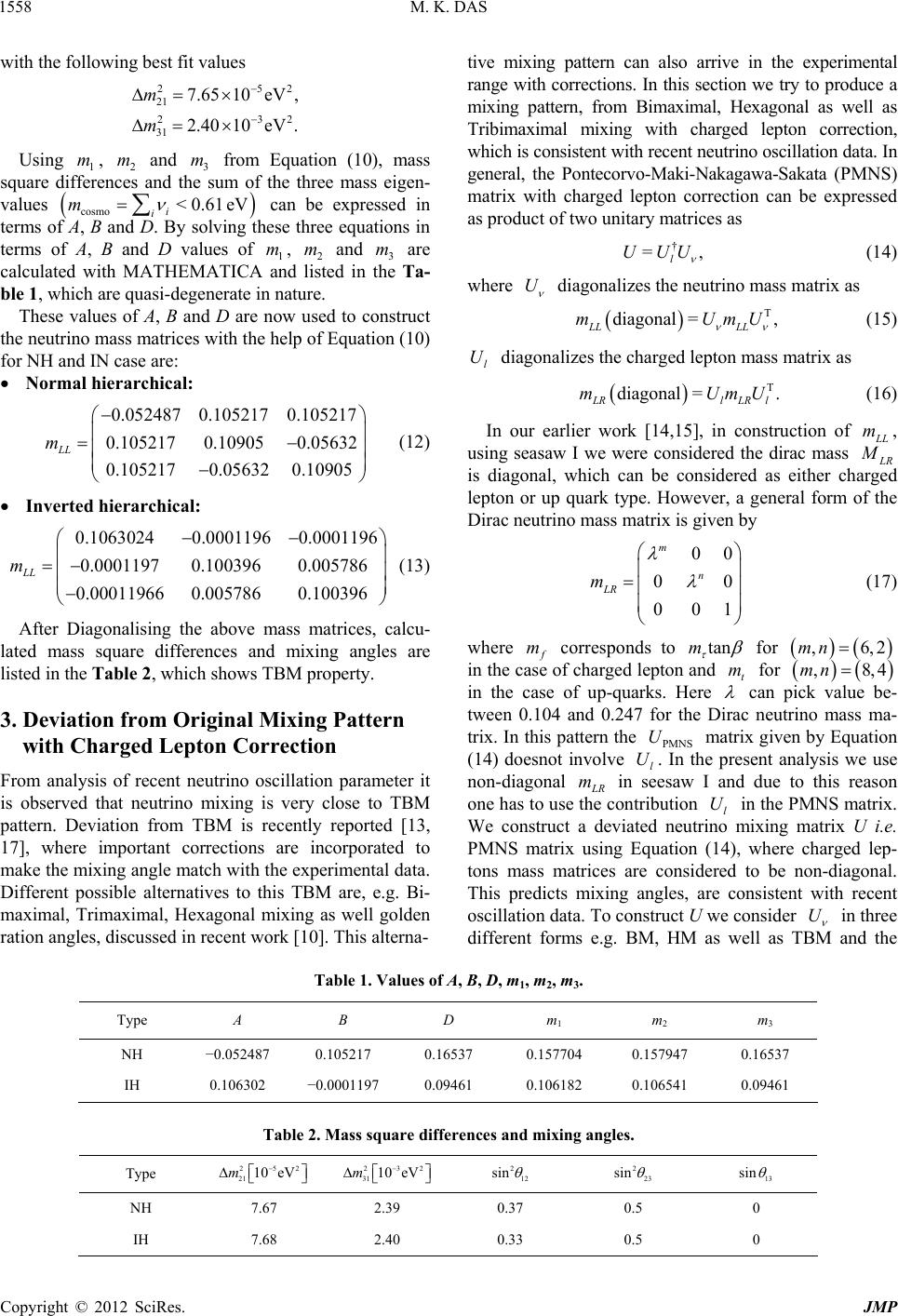 M. K. DAS JMP 1558 252 232 6510eV , 2.4010eV . m m <0.61eV m m 0.105217 0.05632 0.10905 0.0001196 0.005786 0.100396 † =, l UUU tive mixing pattern can also arrive in the experimental range with corrections. In this section we try to produce a mixing pattern, from Bimaximal, Hexagonal as well as Tribimaximal mixing with charged lepton correction, which is consistent with recent neutrino oscillation data. In general, the Pontecorvo-Maki-Nakagawa-Sakata (PMNS) matrix with charged lepton correction can be expressed as product of two unitary matrices as with the following best fit values 21 31 7.m m Using 1, 2 and 3 from Equation (10), mass square differences and the sum of the three mass eigen- values i i can be expressed in terms of A, B and D. By solving these three equations in terms of A, B and D values of 1, 2 and 3 are calculated with MATHEMATICA and listed in the Ta- ble 1, which are quasi-degenerate in nature. m cosmo m m (14) U diagonalizes the neutrino mass matrix as where T diagonal =, LL LL mUmU These values of A, B and D are now used to construct the neutrino mass matrices with the help of Equation (10) for NH and IN case are: (15) l U diagonalizes the charged lepton mass matrix as Normal hierarchical: T diagonal =. RlLRl mUmU (16) 0.052487 0.105217 0.105217 0.10905 0.105217 0.05632 LL m (12) In our earlier work [14,15], in construction of L m, using seasaw I we were considered the dirac mass R is diagonal, which can be considered as either charged lepton or up quark type. However, a general form of the Dirac neutrino mass matrix is given by Inverted hierarchical: 0.1063024 0.0001196 0.0001197 0.100396 0.00011966 0.005786 LL m (13) 00 00 001 m n LR m (17) After Diagonalising the above mass matrices, calcu- lated mass square differences and mixing angles are listed in the Table 2, which shows TBM property. where mtanm corresponds to for ,6,2mn m in the case of charged lepton and t for ,8,4mn in the case of up-quarks. Here can pick value be- tween 0.104 and 0.247 for the Dirac neutrino mass ma- trix. In this pattern the PMNS matrix given by Equation (14) doesnot involve l. In the present analysis we use non-diagonal 3. Deviation from Original Mixing Pattern with Charged Lepton Correction U U R in seesaw I and due to this reason one has to use the contribution l in the PMNS matrix. We construct a deviated neutrino mixing matrix U i.e. PMNS matrix using Equation (14), where charged lep- tons mass matrices are considered to be non-diagonal. This predicts mixing angles, are consistent with recent oscillation data. To construct U we consider From analysis of recent neutrino oscillation parameter it is observed that neutrino mixing is very close to TBM pattern. Deviation from TBM is recently reported [13, 17], where important corrections are incorporated to make the mixing angle match with the experimental data. Different possible alternatives to this TBM are, e.g. Bi- maximal, Trimaximal, Hexagonal mixing as well golden ration angles, discussed in recent work [10]. This alterna- m U U in three different forms e.g. BM, HM as well as TBM and the Table 1. Values of A, B, D, m1, m2, m3. Type A B D m1 m2 m3 NH −0.052487 0.105217 0.16537 0.157704 0.157947 0.16537 IH 0.106302 −0.0001197 0.09461 0.106182 0.106541 0.09461 Table 2. Mass square differences and mixing angles. 252 21 10 eVm 232 31 10 eVm Copyright © 2012 SciRes. Type 2 12 sin 2 23 sin 13 sin NH 7.67 2.39 0.37 0.5 0 IH 7.68 2.40 0.33 0.5 0  M. K. DAS 1559 elements of matrix l are calculated considering it is a Cabibbo-Kobayashi-Maskawa like mixing i.e. [13]: U 23 13 sin , l ab 12 23 sin, sin, ll (18) where varies between 0.104 to 0.247 and a, b varies between 0.2 to 5. From Equation (18) calculated l are used to construct the elements of matrix . l U 3.1. Hexagonal Mixing The standard form of hexagonal mixing matrix is HM 2 =22 22 U 310 2 13 1 22 2 131 22 2 (19) which can predict 2 12 1 sin= 4 , 2 23 1 sin=2 2 sin=0 and 13 . Using Equation (19) one can also construct L m for HM as 1 2 3 00 00 00 mm m HM 310 2 2 131 22 222 131 22 222 310 2 2 131 , 22 222 131 22 222 T LL m (20) and has a texture HM 8 = LL AB mBABD BABD A 8 , 33 88 33 B ABD BD (21) where mass eigenvalues are 12 2 =,= 3 mABm A 3.2. Bimaximal Mixing The standard form of bimaximal mixing is written as: BM 11 0 22 11 1 =22 2 11 1 22 2 U (23) 3 6,=. BmD (22) which predicts 2 12 1 sin 2 , 2 23 1 sin 2 2 13 and sin . Using Equation (23) for the quasi-degenerate case one can construct neutrino mass model for BM case as: 1 HM 2 3 11 0 22 00 11100 22 200 11 1 22 2 11 0 22 11 1 , 22 2 11 1 22 2 T LL m mm m (24) the texture has form [15] 121 1 BM 122 122 12 2 =1 1 Lo mm (25) where mass eigen values are 1112 2112 3 132, 132, o o o mm mm mm m 0.104669 (26) The values can be calculated for HM as well as 1,2, 3 BM case, which are quasi-degenerate in nature using similar procedure adopted in Section 2 for TBM case. For HM A , , 0.128304B 0.210183D and for BM 1 5 7.2 10 3 3.9 10 m , 2 are calcu- lated using MATHEMATICA. Values of mass square differences and mixing angles for BM & HM are given in Table 3. The expression for o is defined as [15] 2 mmv12 6.6 10 o v U ofo Now elements of , where . are taken from Equation (19) and (23) for HM and BM respectively. Then using Equa- tion (18) choosing the suitable value for , a and b ele- ments of l have been calculated. Finally deviated atrix U is constructed using the following equatio U n: m Copyright © 2012 SciRes. JMP 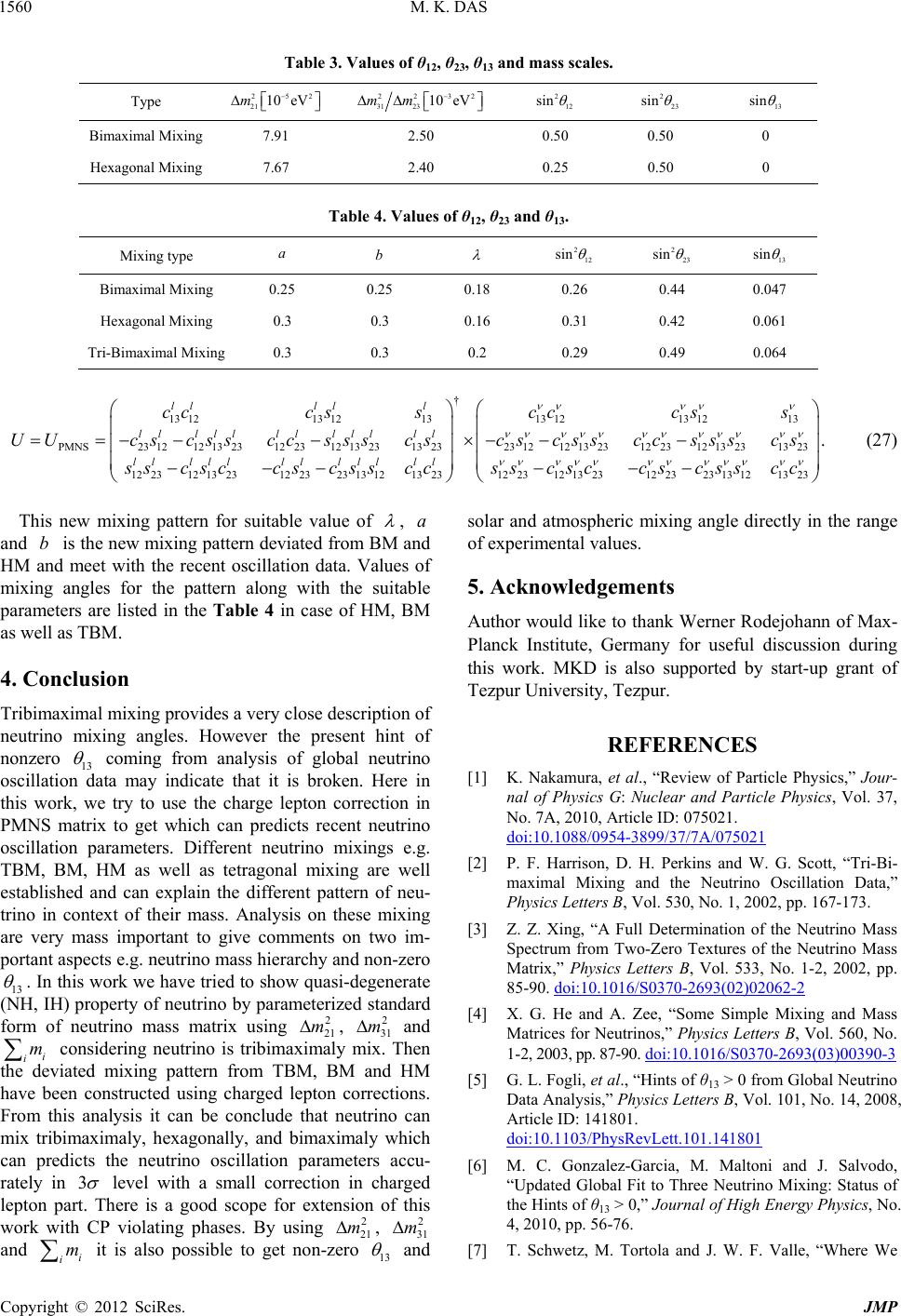 M. K. DAS 1560 Table 3. Values of θ12, θ23, θ13 and mass scales. Type 252 21 10eVm 22 2 31 23 mm 3 10 eV 2 12 sin 2 23 sin 13 sin Bimaximal Mixing 7.91 2.50 0.50 0.50 0 Hexagonal Mixing 7.67 2.40 0.25 0.50 0 Table 4. Values of θ12, θ23 and θ13. Mixing type a b 2 12 sin 2 23 sin 13 sin Bimaximal Mixing 0.25 0.25 0.18 0.26 0.44 0.047 Hexagonal Mixing 0.3 0.3 0.16 0.31 0.42 0.061 Tri-Bimaximal Mixing0.3 0.3 0.2 0.29 0.49 0.064 † 13 1213121313 121312 PMNS23121213 2312231213 2313 2323121213 2312231213 12 2312132312 2323131213 23 llll l lllllll lllll ll lllll lll ll cc csscc cs UUcscsscc ssscscs cssccss ss csccs css cc 12 2312132312 232313 ss csccs cs 13 s 2313 23 1213 23 .scs s cc (27) This new mixing pattern for suitable value of , and is the new mixing pattern deviated from BM and HM and meet with the recent oscillation data. Values of mixing angles for the pattern along with the suitable parameters are listed in the Table 4 in case of HM, BM as well as TBM. a b 4. Conclusion Tribimaximal mixing provides a very close description of neutrino mixing angles. However the present hint of nonzero 13 coming from analysis of global neutrino oscillation data may indicate that it is broken. Here in this work, we try to use the charge lepton correction in PMNS matrix to get which can predicts recent neutrino oscillation parameters. Different neutrino mixings e.g. TBM, BM, HM as well as tetragonal mixing are well established and can explain the different pattern of neu- trino in context of their mass. Analysis on these mixing are very mass important to give comments on two im- portant aspects e.g. neutrino mass hierarchy and non-zero 13 . In this work we have tried to show quasi-degenerate (NH, IH) property of neutrino by parameterized standard form of neutrino mass matrix using 21 , 31 and i i considering neutrino is tribimaximaly mix. Then the deviated mixing pattern from TBM, BM and HM have been constructed using charged lepton corrections. From this analysis it can be conclude that neutrino can mix tribimaximaly, hexagonally, and bimaximaly which can predicts the neutrino oscillation parameters accu- rately in 2 m2 m m 3 level with a small correction in charged lepton part. There is a good scope for extension of this work with CP violating phases. By using 21 , 31 and it is also possible to get non-zero 2 m2 m i im 13 and solar and atmospheric mixing angle directly in the range of experimental values. 5. Acknowledgements Author would like to thank Werner Rodejohann of Max- Planck Institute, Germany for useful discussion during this work. MKD is also supported by start-up grant of Tezpur University, Tezpur. REFERENCES [1] K. Nakamura, et al., “Review of Particle Physics,” Jour- nal of Physics G: Nuclear and Particle Physics, Vol. 37, No. 7A, 2010, Article ID: 075021. doi:10.1088/0954-3899/37/7A/075021 [2] P. F. Harrison, D. H. Perkins and W. G. Scott, “Tri-Bi- maximal Mixing and the Neutrino Oscillation Data,” Physics Letters B, Vol. 530, No. 1, 2002, pp. 167-173. [3] Z. Z. Xing, “A Full Determination of the Neutrino Mass Spectrum from Two-Zero Textures of the Neutrino Mass Matrix,” Physics Letters B, Vol. 533, No. 1-2, 2002, pp. 85-90. doi:10.1016/S0370-2693(02)02062-2 [4] X. G. He and A. Zee, “Some Simple Mixing and Mass Matrices for Neutrinos,” Physics Letters B, Vol. 560, No. 1-2, 2003, pp. 87-90. doi:10.1016/S0370-2693(03)00390-3 [5] G. L. Fogli, et al., “Hints of θ13 > 0 from Global Neutrino Data Analysis,” Physics Letters B, Vol. 101, No. 14, 2008, Article ID: 141801. doi:10.1103/PhysRevLett.101.141801 [6] M. C. Gonzalez-Garcia, M. Maltoni and J. Salvodo, “Updated Global Fit to Three Neutrino Mixing: Status of the Hints of θ13 > 0,” Journal of High Energy Physics, No. 4, 2010, pp. 56-76. [7] T. Schwetz, M. Tortola and J. W. F. Valle, “Where We Copyright © 2012 SciRes. JMP 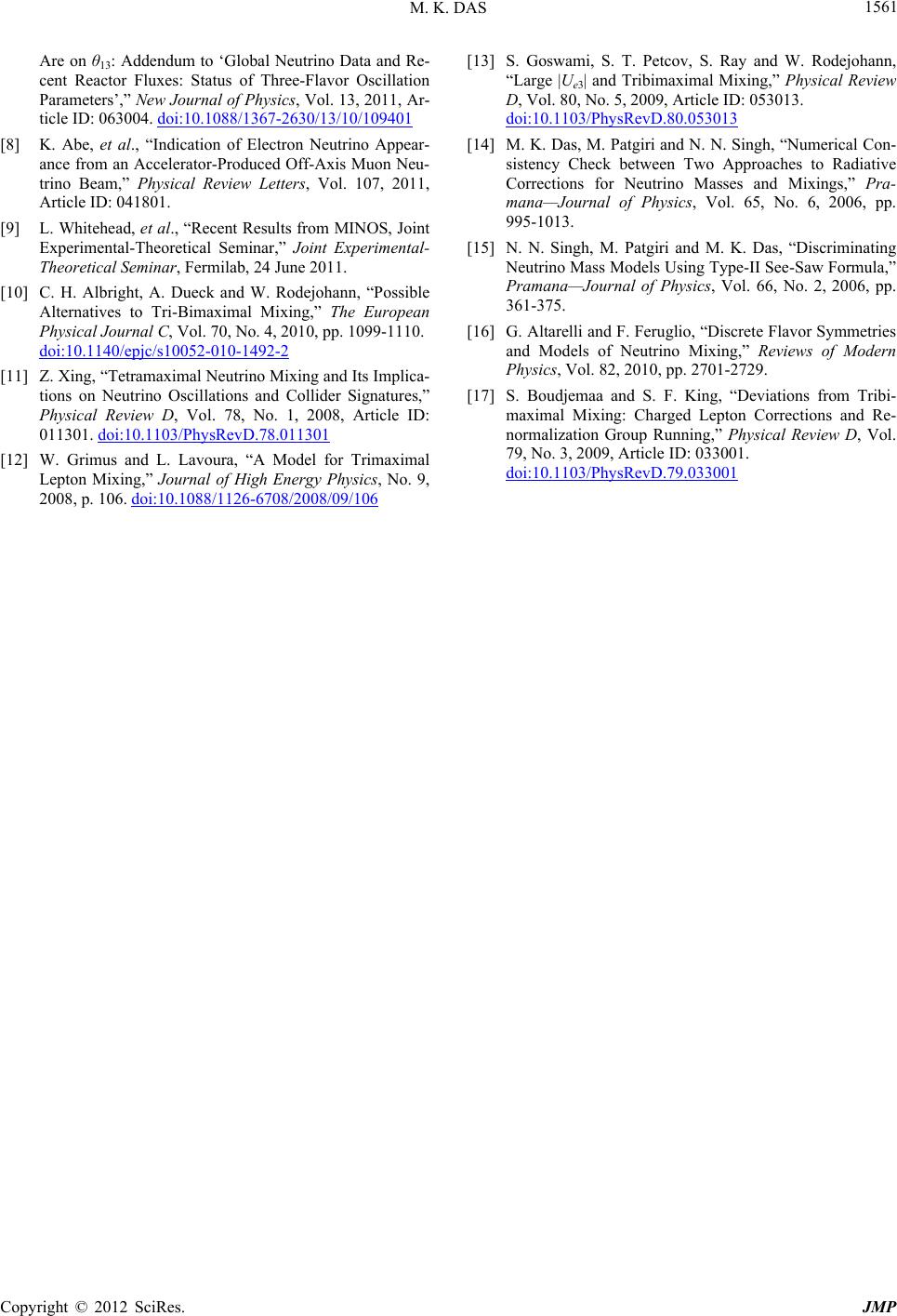 M. K. DAS 1561 Are on θ13: Addendum to ‘Global Neutrino Data and Re- cent Reactor Fluxes: Status of Three-Flavor Oscillation Parameters’,” New Journal of Physics, Vol. 13, 2011, Ar- ticle ID: 063004. doi:10.1088/1367-2630/13/10/109401 [8] K. Abe, et al., “Indication of Electron Neutrino Appear- ance from an Accelerator-Produced Off-Axis Muon Neu- trino Beam,” Physical Review Letters, Vol. 107, 2011, Article ID: 041801. [9] L. Whitehead, et al., “Recent Results from MINOS, Joint Experimental-Theoretical Seminar,” Joint Experimental- Theoretical Seminar, Fermilab, 24 June 2011. [10] C. H. Albright, A. Dueck and W. Rodejohann, “Possible Alternatives to Tri-Bimaximal Mixing,” The European Physical Journal C, Vol. 70, No. 4, 2010, pp. 1099-1110. doi:10.1140/epjc/s10052-010-1492-2 [11] Z. Xing, “Tetramaximal Neutrino Mixing and Its Implica- tions on Neutrino Oscillations and Collider Signatures,” Physical Review D, Vol. 78, No. 1, 2008, Article ID: 011301. doi:10.1103/PhysRevD.78.011301 [12] W. Grimus and L. Lavoura, “A Model for Trimaximal Lepton Mixing,” Journal of High Energy Physics, No. 9, 2008, p. 106. doi:10.1088/1126-6708/2008/09/106 [13] S. Goswami, S. T. Petcov, S. Ray and W. Rodejohann, “Large |Ue3| and Tribimaximal Mixing,” Physical Review D, Vol. 80, No. 5, 2009, Article ID: 053013. doi:10.1103/PhysRevD.80.053013 [14] M. K. Das, M. Patgiri and N. N. Singh, “Numerical Con- sistency Check between Two Approaches to Radiative Corrections for Neutrino Masses and Mixings,” Pra- mana—Journal of Physics, Vol. 65, No. 6, 2006, pp. 995-1013. [15] N. N. Singh, M. Patgiri and M. K. Das, “Discriminating Neutrino Mass Models Using Type-II See-Saw Formula,” Pramana—Journal of Physics, Vol. 66, No. 2, 2006, pp. 361-375. [16] G. Altarelli and F. Feruglio, “Discrete Flavor Symmetries and Models of Neutrino Mixing,” Reviews of Modern Physics, Vol. 82, 2010, pp. 2701-2729. [17] S. Boudjemaa and S. F. King, “Deviations from Tribi- maximal Mixing: Charged Lepton Corrections and Re- normalization Group Running,” Physical Review D, Vol. 79, No. 3, 2009, Article ID: 033001. doi:10.1103/PhysRevD.79.033001 Copyright © 2012 SciRes. JMP
|